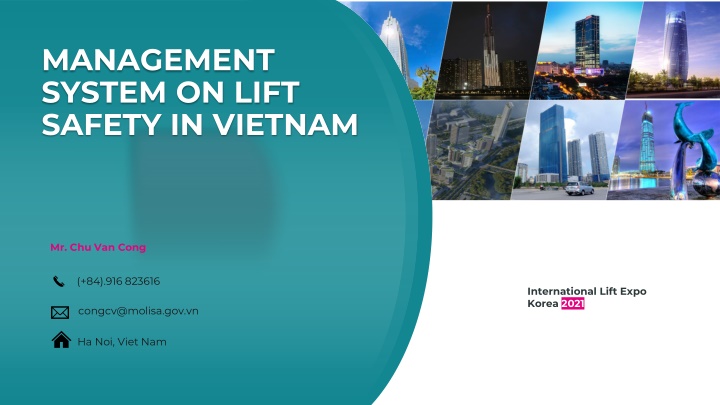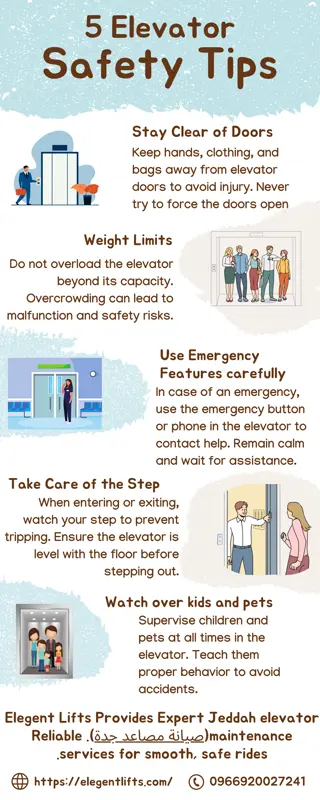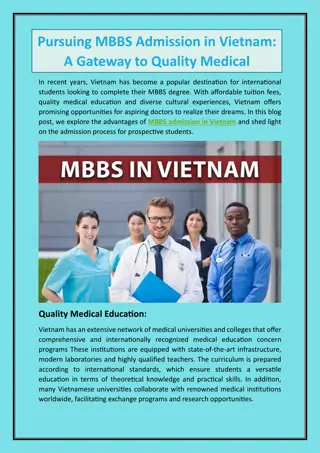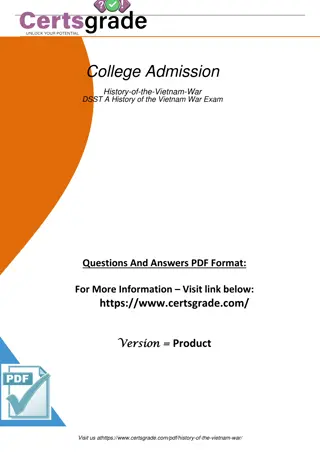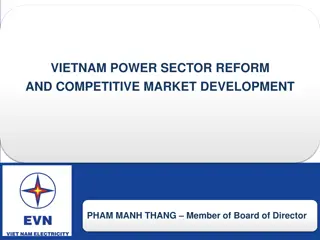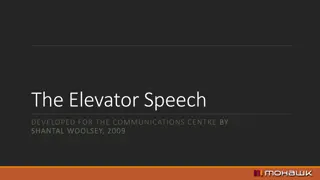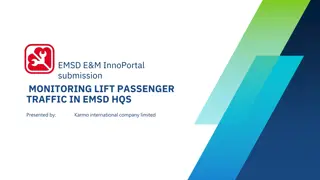Elevator Safety Management System in Vietnam
Elevator safety management in Vietnam is governed by various laws, regulations, and national technical standards. The system faces challenges like limited investment in certification facilities and lack of interest in data building and elevator maintenance. Despite these, the market shows potential with the rapid urbanization and rise in high-rise buildings. Current statistics indicate 300,000 elevators installed and used in Vietnam, with an annual market of 8,000 units. National regulations cover safe work for various types of lifts, emphasizing safety requirements in construction, installation, and testing.
Download Presentation

Please find below an Image/Link to download the presentation.
The content on the website is provided AS IS for your information and personal use only. It may not be sold, licensed, or shared on other websites without obtaining consent from the author.If you encounter any issues during the download, it is possible that the publisher has removed the file from their server.
You are allowed to download the files provided on this website for personal or commercial use, subject to the condition that they are used lawfully. All files are the property of their respective owners.
The content on the website is provided AS IS for your information and personal use only. It may not be sold, licensed, or shared on other websites without obtaining consent from the author.
E N D
Presentation Transcript
MANAGEMENT SYSTEM ON LIFT SAFETY IN VIETNAM Mr. Chu Van Cong (+84).916 823616 International Lift Expo Korea 2021 congcv@molisa.gov.vn Ha Noi, Viet Nam
LIFT o Law technical 2006 o Law on product and goods quality in 2007 o The OSH Law in 2015 on standards regulations and in MANAGEMENT SYSTEM IN VIETNAM LAW o Decree No. 127/2007/ND-CP Detailing a number of articles of the Law on Standards and Technical Regulations o Decree No. 39/2016/ND-CP Detailing the implementation of a number of articles of the Law on occupational safety and health o Decree No. 78/2018/ND-CP Amending and supplementing a number of articles Government's Decree No. 127/2007 / ND-CP DECREE Circular issued National technical regulation QCVN 02: 2011/BL TBXH QCVN 18: 2013/BL TBXH QCVN 26: 2016/BL TBXH QCVN 32: 2018/BL TBXH QCVN 02: 2019/BL TBXH CIRCULARS of the DECISION, DIRECTIVE
CURRENT Status Installed and used in Viet Nam 300.000 Total On the market 8000 Pcs/Year
CURRENT Status Advantages With the speed of urbanization, high-rise buildings sprout up rapidly Elevator market in Vietnam is currently one of the potential markets Dis-Advantages Investment in facilities for certification and testing activities is still limited Database on the elevator has not been interested in building, the data is only based on data reported from the organization through hard documents. Users are still not interested in the maintenance and routine maintenance of elevators
2011 QCVN 02 National regulation on safe work for electric lift 2016 QCVN 26 National regulation on safe work for machine electric lift technical technical room-less 2013 QCVN 18 National regulation on safe work for Hydraulic lift 2019 QCVN 02 National regulation on safe work for lift technical technical 2018 QCVN 32 National regulation on safe work for home lift technical TECCHNICAL REGULATION
NATIONAL TECCHNICAL REGULATION ON SAFETY FOR LIFT TCVN 6396-20:2017 EN 81-20:2014 Safety requirements on elevator construction and installation transporting people and goods - Part 20: Passenger elevators and elevators carrying people and goods QCVN 02: 2019/BL TBXH - Elevators for TCVN 6396-50:2017 EN 81-50:2014 Safety requirements on structure and lift installation - Testing and testing - Part 50: Requirements on design, calculation, inspection and testing Test elevator parts
NATIONAL TECCHNICAL REGULATION ON SAFETY FOR LIFT 1. General rules 1.1 Scope of application 1.2 Subjects of application 1.3 Terminology and definitions 2. Technical regulations 3. Regulations on quality management 4. Responsibilities of organizations and individuals 5. Implementation organization
Applies: NATIONAL TECCHNICAL REGULATION ON SAFETY FOR LIFT o Machine room or machine room-less o Hydraulic Does not apply: Scope of application o Home elevators are regulated in QCVN 32:2018/BLDTBXH Regulations oHave a rated speed 0.15 m/s o Hydraulic ladder with rated speed exceeding 1 m/s o Hydraulic elevators with rated speed exceeding 1 m/s or hydraulic elevators if the pressure relief valve is set to exceed 50 MPa o Lifting devices, reels, mine lifts, stage lifts, automatic bucket lifts, lifts, lifts and hoists for construction sites of public buildings and buildings, winches on ships, offshore exploration or drilling rigs, construction and maintenance equipment or lifts in wind turbines Other provision: o For elevators installed in existing buildings, EN 81-21 can be applied o In addition to meeting the requirements of this Regulation, elevators must meet additional requirements according to specialized laws in special cases.
1. General NATIONAL TECCHNICAL REGULATION ON SAFETY FOR LIFT 2. Well, machinery spaces and pulley rooms 3. Landing doors and car doors Technical regulations 4. Car, counterweight and balancing weight 5. Suspension means, compensation means and related protection means 6. Precautions against free fall, excessive speed, unintended car movement and creeping of the car 7. Guide rails 8. Buffers 9. Lift machinery and associated equipment 10. Electric installations and appliances 11. Protection against electric faults; failure analysis; electric safety devices 12. Controls - Final limit switches - Priorities
INSPECTION INSPECTION COMFORMITY COMFORMITY Management regulations MAINTENANCE MAINTENANCE USING USING
COMFORMITY ACTIVITY D o m e s t i c p r o d u c t i o n C o n f o r m i t y a n n o u n c e m e n t I m p o r t p r o d u c t i o n C h e c k t h e q u a l i t y w h e n i m p o r t i n g C e r t i f i c a t i o n m e t h o d M e t h o d p r o m u l g a t e d 2 8 / 2 0 1 2 / T T - B K H C N 0 2 / 2 0 1 7 / T T - B K H C N 5 , m e t h o d t o g e t h e r 7 w i t h & o r m e t h o d C i r c u l a r C i r c u l a r 8 N o . N o .
CERTIFICATION BODY o Appointed by Molisa o Facilities for certification activities o At least 04 Auditors Number of certification bodies: 20
TECHNICAL SAFETY INSPECTION Technical inspection of elevator safety is carried out according to the inspection process issued by the Ministry of Labor FIRST TIME PERIODIC ABNORMAL inspection into use for the first time. before put inspection the expiration of the previous accreditation visit inspection upgrade, request of the competent authorities when: renovate; Repair, Upon
INSPECTION BODY Appointed by MOLISA Facilities At least 02 inspectors 68
MAINTENANCE 03 month Under normal conditions 01 month Elevators are installed in apartments, office buildings, commercial center buildings, hospitals, manufacturing plants, public areas hotels,
USER USER RESPONSIBILITIES RESPONSIBILITIES o Technical inspection before put into use o Keeping the records and documents relating to lifts o Arrange at least 01 person to be responsible for elevator operation o Declare the use of the elevator with the local Labor Office
VISION & MISSION Building database elevator management Improving the quality of elevator inspection, testing and inspection activities Strengthening cooperation, experience from developed countries international management learning
